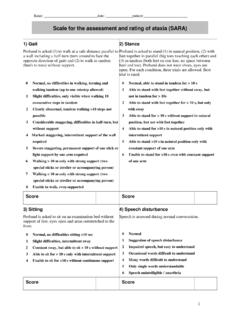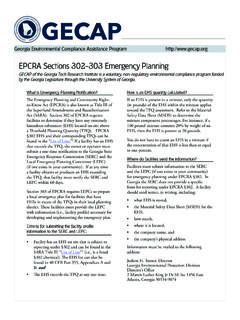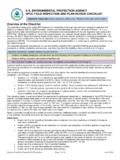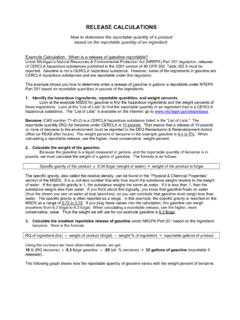Transcription of Dynamic Routing Between Capsules - arXiv
1 Dynamic Routing Between CapsulesSara SabourNicholas FrosstGeoffrey E. HintonGoogle BrainToronto{sasabour, frosst, capsule is a group of neurons whose activity vector represents the instantiationparameters of a specific type of entity such as an object or an object part. We usethe length of the activity vector to represent the probability that the entity exists andits orientation to represent the instantiation parameters. Active Capsules at one levelmake predictions, via transformation matrices, for the instantiation parameters ofhigher-level Capsules . When multiple predictions agree, a higher level capsulebecomes active.}
2 We show that a discrimininatively trained, multi-layer capsulesystem achieves state-of-the-art performance on MNIST and is considerably betterthan a convolutional net at recognizing highly overlapping digits. To achieve theseresults we use an iterative Routing -by-agreement mechanism: A lower-level capsuleprefers to send its output to higher level Capsules whose activity vectors have a bigscalar product with the prediction coming from the lower-level IntroductionHuman vision ignores irrelevant details by using a carefully determined sequence of fixation pointsto ensure that only a tiny fraction of the optic array is ever processed at the highest is a poor guide to understanding how much of our knowledge of a scene comes fromthe sequence of fixations and how much we glean from a single fixation.
3 But in this paper we willassume that a single fixation gives us much more than just a single identified object and its assume that our multi-layer visual system creates a parse tree-like structure on each fixation, andwe ignore the issue of how these single-fixation parse trees are coordinated over multiple trees are generally constructed on the fly by dynamically allocating memory. Following Hintonet al. [2000], however, we shall assume that, for a single fixation, a parse tree is carved out of a fixedmultilayer neural network like a sculpture is carved from a rock. Each layer will be divided into manysmall groups of neurons called Capsules (Hinton et al.)
4 [2011]) and each node in the parse tree willcorrespond to an active capsule . Using an iterative Routing process, each active capsule will choose acapsule in the layer above to be its parent in the tree. For the higher levels of a visual system, thisiterative process will be solving the problem of assigning parts to activities of the neurons within an active capsule represent the various properties of a particularentity that is present in the image. These properties can include many different types of instantiationparameter such as pose (position, size, orientation), deformation, velocity, albedo, hue, texture, very special property is the existence of the instantiated entity in the image.
5 An obvious way torepresent existence is by using a separate logistic unit whose output is the probability that the entityexists. In this paper we explore an interesting alternative which is to use the overall length of thevector of instantiation parameters to represent the existence of the entity and to force the orientation31st Conference on Neural Information Processing Systems (NIPS 2017), Long Beach, CA, [ ] 7 Nov 2017of the vector to represent the properties of the entity1. We ensure that the length of the vector outputof a capsule cannot exceed1by applying a non-linearity that leaves the orientation of the vectorunchanged but scales down its fact that the output of a capsule is a vector makes it possible to use a powerful Dynamic routingmechanism to ensure that the output of the capsule gets sent to an appropriate parent in the layerabove.
6 Initially, the output is routed to all possible parents but is scaled down by coupling coefficientsthat sum to1. For each possible parent, the capsule computes a prediction vector by multiplying itsown output by a weight matrix. If this prediction vector has a large scalar product with the output ofa possible parent, there is top-down feedback which increases the coupling coefficient for that parentand decreasing it for other parents. This increases the contribution that the capsule makes to thatparent thus further increasing the scalar product of the capsule s prediction with the parent s type of Routing -by-agreement should be far more effective than the very primitive form ofrouting implemented by max-pooling, which allows neurons in one layer to ignore all but the mostactive feature detector in a local pool in the layer below.
7 We demonstrate that our Dynamic routingmechanism is an effective way to implement the explaining away that is needed for segmentinghighly overlapping neural networks (CNNs) use translated replicas of learned feature detectors. Thisallows them to translate knowledge about good weight values acquired at one position in an imageto other positions. This has proven extremely helpful in image interpretation. Even though we arereplacing the scalar-output feature detectors of CNNs with vector-output Capsules and max-poolingwith Routing -by-agreement, we would still like to replicate learned knowledge across space. Toachieve this, we make all but the last layer of Capsules be convolutional.
8 As with CNNs, we makehigher-level Capsules cover larger regions of the image. Unlike max-pooling however, we do not throwaway information about the precise position of the entity within the region. For low level Capsules ,location information is place-coded by which capsule is active. As we ascend the hierarchy,more and more of the positional information is rate-coded in the real-valued components of theoutput vector of a capsule . This shift from place-coding to rate-coding combined with the fact thathigher-level Capsules represent more complex entities with more degrees of freedom suggests that thedimensionality of Capsules should increase as we ascend the How the vector inputs and outputs of a capsule are computedThere are many possible ways to implement the general idea of Capsules .
9 The aim of this paper is notto explore this whole space but simply to show that one fairly straightforward implementation workswell and that Dynamic Routing want the length of the output vector of a capsule to represent the probability that the entityrepresented by the capsule is present in the current input. We therefore use a non-linear"squashing"function to ensure that short vectors get shrunk to almost zero length and long vectors get shrunk to alength slightly below1. We leave it to discriminative learning to make good use of this ||sj||21 +||sj||2sj||sj||(1)wherevjis the vector output of capsulejandsjis its total all but the first layer of Capsules , the total input to a capsulesjis a weighted sum over all prediction vectors uj|ifrom the Capsules in the layer below and is produced by multiplying theoutputuiof a capsule in the layer below by a weight matrixWijsj= icij uj|i, uj|i=Wijui(2)
10 Where thecijare coupling coefficients that are determined by the iterative Dynamic Routing coupling coefficients Between capsuleiand all the Capsules in the layer above sum to1and aredetermined by a Routing softmax whose initial logitsbijare the log prior probabilities that capsulei1 This makes biological sense as it does not use large activities to get accurate representations of things thatprobably don t be coupled to (bij) kexp(bik)(3)The log priors can be learned discriminatively at the same time as all the other weights. They dependon the location and type of the two Capsules but not on the current input image2.
![arXiv:0706.3639v1 [cs.AI] 25 Jun 2007](/cache/preview/4/1/3/9/3/1/4/b/thumb-4139314b93ef86b7b4c2d05ebcc88e46.jpg)

![arXiv:1301.3781v3 [cs.CL] 7 Sep 2013](/cache/preview/4/d/5/0/4/3/4/0/thumb-4d504340120163c0bdf3f4678d8d217f.jpg)
![@google.com arXiv:1609.03499v2 [cs.SD] 19 Sep 2016](/cache/preview/c/3/4/9/4/6/9/b/thumb-c349469b499107d21e221f2ac908f8b2.jpg)












